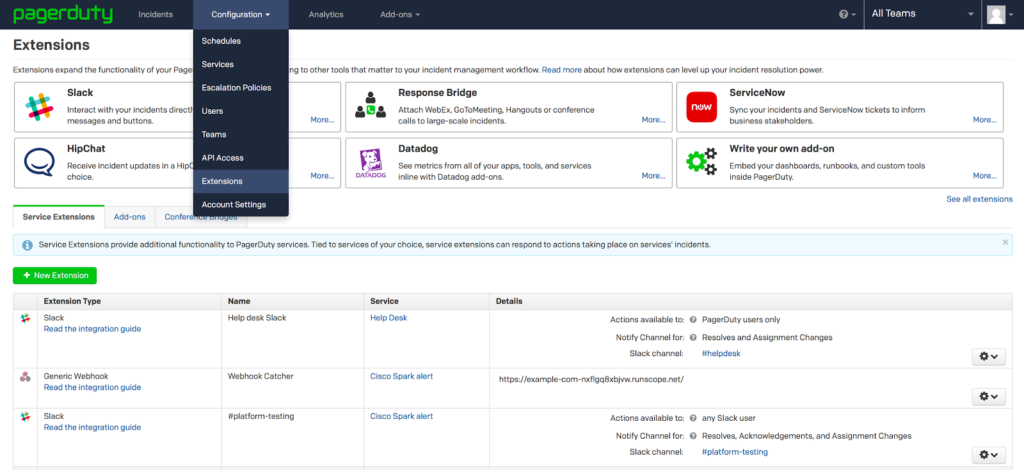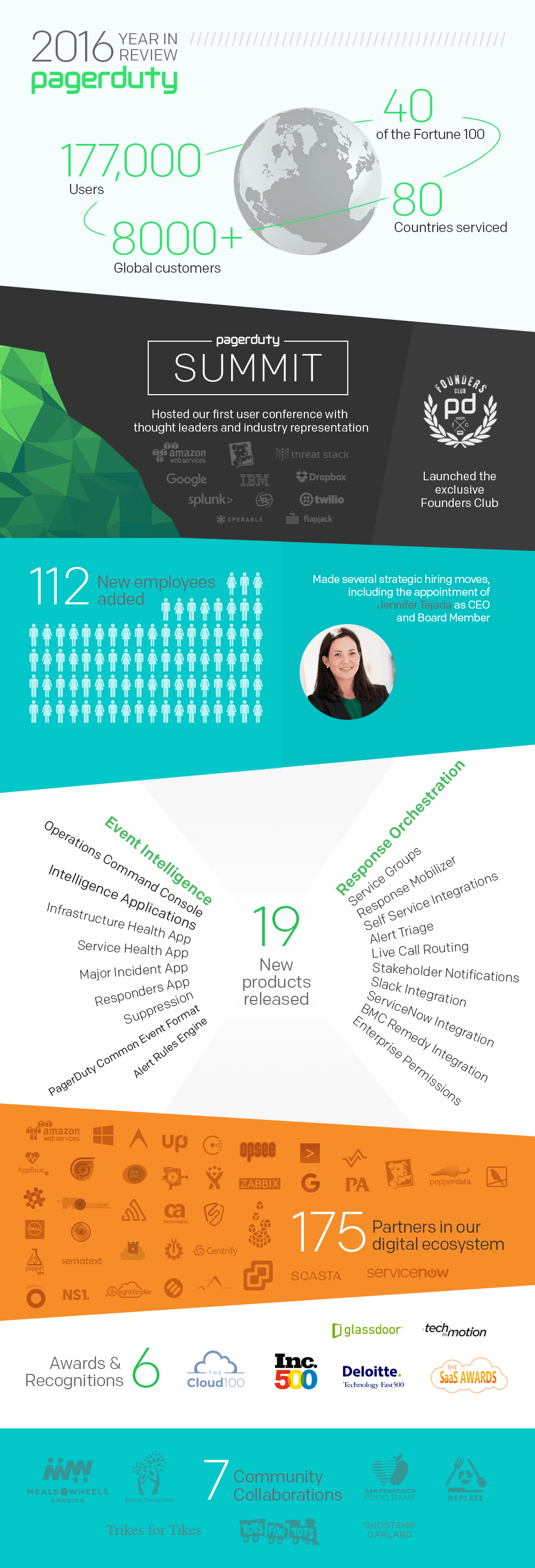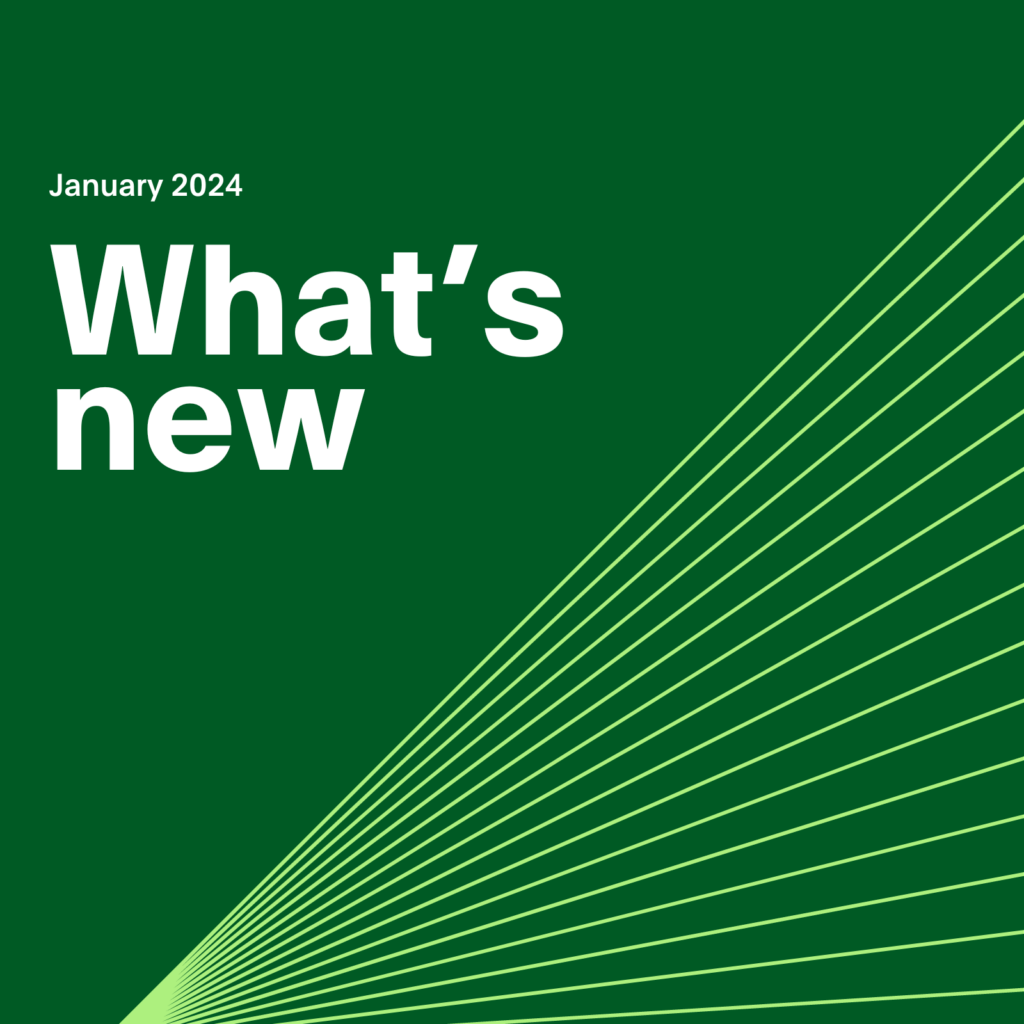- PagerDuty /
- Blog /
- Uncategorized /
- 2016: Year-In-Review
Blog
2016: Year-In-Review
2016 has been a great year for PagerDuty, as we’ve had a momentous year of rapid innovation, transformation, and growth. As we take this time to reflect on everything we’ve been through this year, we’d like to share a little bit about what took place in 2016 and how we arrived at where we are today.
Core Platform Integrations
We kicked off 2016 by launching a fresh new website, new product videos, and a new range of product capabilities spanning from event grouping and enrichment, to mobile incident management, real-time collaboration, and much more. We launched multiple capabilities and initiatives to empower IT Ops, DevOps, and development teams with a highly extensible PagerDuty platform and developer API.
The Product team made strides in delivering seamless native integrations with:
- Infrastructure monitoring tools like Microsoft Azure and Google Stackdriver
- Log monitoring and analytics tools such as Splunk
- ITSM tools including ServiceNow, BMC Remedy, and CA UIM
Now, with 175+ native integrations, you’d be hard pressed to find a tool in your environment that you couldn’t integrate with PagerDuty in clicks.
We also shared how to build a chat integration with Cisco Spark and how to create custom flows to connect PagerDuty to more services via Microsoft Flow Templates. This year we also delivered Service Groups, a way for users to easily group multiple integrations within PagerDuty that monitor the various layers of their service.
Platform Extensibility
With the release of a new iteration of our API — API v2.0 — we made it easier to test API calls in-line within the documentation library, embed PagerDuty into apps, embed apps into PagerDuty, and create custom integrations to essentially any source with the Custom Events Transformer. We made it easy to extend functionality with our API to get exactly what you want out of your PagerDuty experience. If you can dream it, you can build it!
We also delivered a special class of integrations called Workflow Extensions and provided a centralized location within the product to easily extend and configure PagerDuty workflows to all your existing tools.
We also made it easy for anyone to immediately reach the on-call team or responder to report incidents in real-time via Live Call Routing, which forwards calls with your existing schedules and escalation policies or appends voicemails to incidents.
We introduced Add-Ons — a way to add functionality to PagerDuty outside of the service, giving you the ability to:
- Embed live service metrics from Datadog into PagerDuty incidents
- Pre-configure conference bridge and online meeting details to be able to add to any incident
- Detect conflicts between schedules
- Pre-configure a view of PagerDuty’s status page
- Visualize incident density graphs that reveal trends about when incidents are triggered
- And so much more!
 PagerDuty also enhanced Enterprise-Grade Security by joining the highly reputable Cloud Security Alliance (CSA) among AWS, Microsoft Azure, and more. Administrators can leverage fine-grained role-based access control across more objects in PagerDuty than ever before.
PagerDuty also enhanced Enterprise-Grade Security by joining the highly reputable Cloud Security Alliance (CSA) among AWS, Microsoft Azure, and more. Administrators can leverage fine-grained role-based access control across more objects in PagerDuty than ever before.
Event Intelligence
When you get woken up in the middle of the night by a critical issue, it can be difficult to comprehend the context and details about incidents when they’re coming from different sources. For this reason, we released the PagerDuty Common Event Format to help normalize events from disparate systems so you can quickly comprehend and resolve issues faster.
We introduced a series of product capabilities aimed towards optimizing event intelligence.
- Responders can now group related alerts into a single incident object, customize incident titles, leverage bulk actions, and more with Alert Triage.
- We made it easier to focus on what’s actionable via Suppression — an intelligent event rules engine to facilitate dynamic event management from any system so you can exercise full control over what you want to be notified on. Non-actionable alerts are retained to reveal patterns and leading edge indicators of problems, while actionable alerts can be grouped into incidents that trigger a response.
- We made huge strides with Operations Command Console and Intelligence Applications, providing teams with the full-stack visibility and actionable insights they need to orchestrate better business and technical response to incidents, all in one place.
If you haven’t already, check out the Q4 What’s New with PagerDuty webinar recording where we share a demo of how all these capabilities tie together into an end-to-end workflow.
Response Orchestration
Once you have full-stack visibility into your infrastructure, how do you orchestrate the ideal response and quickly engage responders to work on critical incidents?
We released several important capabilities that enable powerful end-to-end response workflows:
- Direct Incident Assignment: exercise full control over who an incident is assigned to.
- Response Mobilizer: easily recruit additional experts and responders at scale
- Response Bridge: enable members to quickly collaborate in a conference bridge
- Response Notes: streamline context sharing and enable easier postmortems by time stamping important details
Farewell to 2016 and Hello to 2017!
PagerDuty has truly matured and transformed its core platform to be more agile and lean, delivering a wealth of capabilities beyond just IT alerting and on-call automation. PagerDuty helps organizations across the world as they modernize their operations and embark on the path of digital transformation. Better operating systems and services can improve the lives of your operations and development teams and in turn, help them deliver better software and better customer experiences.
We look forward to doing even more to delight our customers in this upcoming year!
Interested in keeping up with the latest features and capabilities from PagerDuty? Register for our What’s New with PagerDuty webinar, a quarterly webinar where our technical experts demonstrate our newest innovations and product capabilities.
We did a lot to build a better product for our customers, but we also accomplished a lot as company. Take a look at the infographic below to see what else PagerDuty achieved in 2016!



